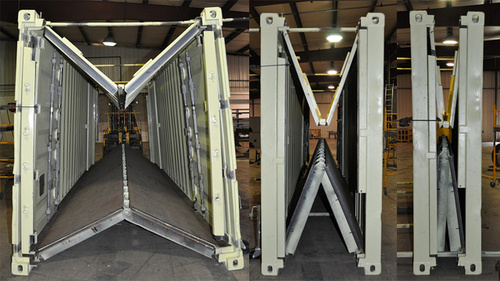If you’re a shipper, this problem may be a familiar one: you load your products into containers and send them off to wherever their destination is, but there isn’t an equal size shipment at the destination that needs to come back your way. So when the containers are returned, they’re empty. All this has accomplished is an unfortunate waste of time and money, as each empty container takes up space that could be used to transport other goods. But what choice do you have? After all, you need to get the containers back, and there’s no other way to do it, right?
The future of shipping containers
The woes of “lopsided trade” are somewhat common in ocean transport. They exist in developing areas as well as regions in Oceania, the Caribbean islands, and certain domestic markets – particularly Hawaii, Alaska, and Guam. That’s why a number of companies have done their research and are looking for ways to create an innovative solution to an age-old problem. One potential answer to this frustrating consequence of shipment imbalance lies in the collapsible container. Companies like Holland Container Innovations, Staxxon, Cargoshell, and Florida-based Compact Cargo Solutions have all come up with their own versions of folding containers.
Innovative containers currently being tested
For example, HCI has created about ten of its “4FOLD” containers, which are currently being tested by both the American Bureau of Shipping and the Korean Register of Shipping. Once they are folded flat, about four of the containers can fit in the space that would otherwise be occupied by one regular container. The containers are designed to easily fold flat using equipment like reach stackers. Although their current designs are only for 40-ft. containers, HCI reps have indicated that they hope to expand into 53-ft. and other sizes as well.
Staxxon came up with a somewhat different design. Their plans are currently only for 20-ft. containers, which is where they believe the most potential is – especially for developing economies where trade is particularly lopsided. And instead of folding flat, the Staxxon containers instead collapse from left to right, making room for two to five containers where one empty one would normally stand. There are currently seven of the prototypes in testing, which are compliant with the International Maritime Organization’s Convention for Safe Containers.
The obvious (and not so obvious) benefits of foldable containers
So will these containers really get the job done? There seem to be two immediate benefits – freeing up real estate at the terminal and creating more space on container ships (which are often on the smaller end) for laden cargo. But there are certain less obvious advantages too. For example, because multiple folded “empties” can be lifted at once, they may reduce the total number of lifts needed to load or unload a ship, thus speeding up the process at both ends of the supply chain. Of course, on the downside, these containers cost more than traditional, non-trick-performing versions. One estimate from Staxxon is that these innovative containers will initially cost about 30% more than traditional containers, although a representative from HCI suggested that the price could fall significantly in the coming years. Either way, all signs point to a good investment, as the cost can be earned back in at least the same time as it takes for other containers, and potentially in as little as 18 months.
Although none of these containers are in widespread use yet, and it might take awhile before they are approved for common use, these companies have clearly identified a need in the industry and are looking to fill that need.






3 Comments on “Collapsible Shipping Containers: Solving the Issue of Lopsided Trade?”
i want to sent some gift to malaysia by shiping
Hello Mian,
Thank you for reaching out. I will forward your request to a member of our Business Development team. They should be emailing you soon!
Thank you,
Gabby
I am so thankful to you for sharing information, about Collapsible Shipping Containers. Well done and post more such amazing blogs here.